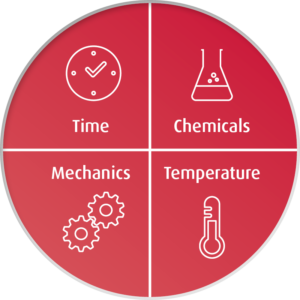How does a car wash work?
As a car wash operator, you know all about washing processes in your facility. To round off the overall understanding, we would like to give you answers to the question “How does a car wash work?” from a scientific point of view in this article. To understand, we need the Sinner’s Circle.
Sinner’s circle illustrates the parameters of temperature, time, chemistry and mechanics as basic elements of cleaning and consequently applies in a car wash as well.
The principle of Sinner’s circle is named after the surfactant chemist Herbert Sinner and includes the factors chemistry, mechanics, temperature and time as basic parameters for every cleaning process.
For the specific scenario of a car wash, we want to add the factor water as a fifth parameter, since it is qualitatively essential for this specific process. Sinner’s circle is illustrated by a pie chart, where the sum of the factors always remains the same if you want to achieve successful car wash results.
Simply put: If it is lacking in one place, another factor must be increased. Imagine you are washing your hands but only have cold water available (temperature). Your hands will only get clean if either you wash longer (time), scrub harder with a brush (mechanical), or use a little more soap (chemical) to compensate.
An efficient, high quality car wash needs good quality water, a working supporting mechanical system with high pressure, cleaning rollers and sponges, a sufficiently high temperature and wash time, and of course top-notch chemical agents to clean effectively.
However, the latter can also ensure that the other factors are balanced out, for example if recycled water is used or the wash cycle is to be particularly fast.
Would you like to benefit from Caramba’s many years of experience in operating your car wash?
You’d like a consultation at your site?
